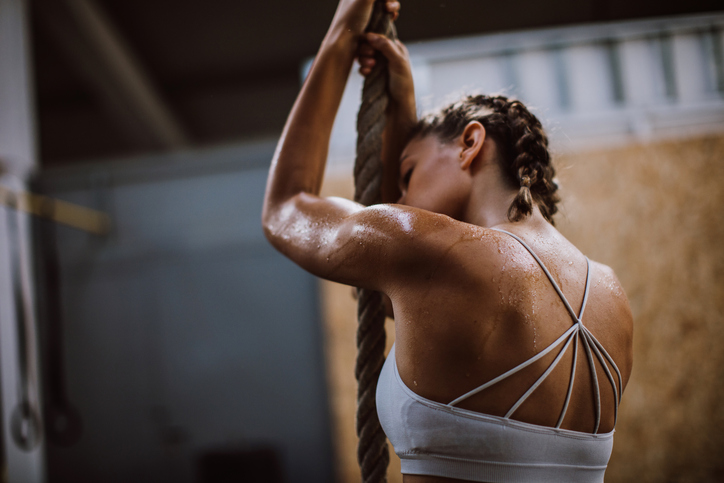Comment gérer sereinement le retour de vacances
Le retour de vacances, c’est souvent très compliqué et la reprise sportive l’est d’autant plus.
Les vacances, c'était bien, pas vrai ? Comme si l’ensemble de tes soucis s’étaient tout bonnement évaporés. Et ce, en même temps que tes engagements envers le sport.
Sauf que maintenant, il faut reprendre !
Comme tu le sais, le plus dur, c’est de s’y mettre. Mais une fois le train en marche, il est impossible de l’arrêter !
Je peux te garantir que si tu suis scrupuleusement mes conseils, tu retrouveras ton meilleur niveau d’ici très peu de temps.
1) Faire le bilan
Avant toutes choses, tu vas devoir faire le bilan de ces 3 derniers mois et évaluer ta condition actuelle. La raison est simple : si tu veux repartir sur de bonnes bases, tu dois te fixer de nouveaux objectifs ! Il est donc nécessaire de connaître ta progression des derniers mois pour, ensuite, entreprendre de nouvelles choses.
Par exemple, si comme la plupart des gens durant les vacances d’été, tu as passé le plus clair de ton temps à te prélasser au soleil (sans prêter attention à ton entraînement ou ton alimentation), ton 1er objectif sera de reprendre un mode de vie plus “sain”. Mais entre nous, ça fait toujours du bien de faire un petit “break” avec la musculation, pour repartir de plus belle à la rentrée. :)
Le problème, c’est que ce “petit break” peut très vite s’éterniser et se transformer en habitude. Donc raison de plus pour faire un bilan et voir où tu en es.
“Je veux bien faire un bilan, mais par où commencer ?”
Pas d’inquiétude ! Je vais te partager les consignes à appliquer pour te remettre sur les rails en un rien de temps !
Tout d’abord, je te conseille de prendre tes mensurations.
Et oui, tu n’es pas sans savoir qu’elles sont d’une aide précieuse concernant ton évolution, surtout en musculation ! Les mensurations peuvent se montrer très précises, si les mêmes conditions sont réunies à chaque mesure.
La mesure la plus significative sera le tour de taille. Mais il sera important de prendre d’autres mesures pour avoir des points de comparaison, afin de déterminer si tu perds du gras, du muscle ou si tu prends du gras et/ou du muscle.
Par exemple, si tu perds 2 cm de tour de taille, en ayant pris 1 cm de tour de bras et en pesant 1 kg de plus, on peut en conclure sans trop de risques, que tu as pris du muscle.
Tout simplement puisque la majeure partie des personnes (surtout les hommes) stockent du gras principalement autour de la sangle abdominale. Les femmes, quant à elles, stockeront majoritairement sur le bas du corps (raison de plus pour prendre également le tour de cuisses).
Je te conseille donc de mesurer :
- ton tour de cuisses
- ton tour de hanches
- ton tour de taille
- ton tour d’épaules
- ton tour de bras
En parallèle, pèse-toi.
Quoi ? Tu as entendu dire qu’il ne fallait surtout pas se fier à la balance ?
C’est effectivement le cas, si la balance est le seul indicateur dont tu disposes.
Mais si tu la combines aux mensurations, elle t’apportera énormément de précision pour ton bilan final. Tu peux également prendre ta masse grasse, pour ajouter des données supplémentaires.
Je te vois venir : “Mesurer la masse grasse ? Ça à l'air d'être compliqué ! Je n’ai pas envie de me prendre la tête.”
Je te rassure, c’est un jeu d’enfant !
Pour information, les mensurations ainsi que la balance suffisent amplement pour évaluer ta progression avec précision. Mais si tu veux aller un peu plus loin, je te conseille d'évaluer ta masse grasse.
Tu as simplement besoin d’une pince à plis cutanés, avec un système de ressorts (attention : les pinces 1er prix, entièrement en plastique, ne sont pas du tout fiables).
Une fois que tu auras trouvé une pince suffisamment précise, tu devras mesurer l’épaisseur de ta peau à différents endroits de ton corps, pour ensuite en déterminer ton pourcentage de masse grasse (les mesures, ainsi que les calculs, sont normalement expliqués dans le manuel de la pince).
L’étape suivante consistera à prendre des photos de ta condition physique actuelle.
Je te conseille d’en faire sous plusieurs angles, pour être certain d’avoir une vue d’ensemble.
Petite astuce : tu peux également te prendre en vidéo en te tournant de face, de profil et de derrière. Tu peux aussi faire des photos en étant relâché et contracté.
Une fois que tu auras toutes ces informations à ta disposition, tu sauras si tu as perdu du muscle et/ou pris du gras, durant ces vacances d’été.
À partir de là, tu pourras enfin te fixer de nouveaux objectifs. C’est notre prochain point.
2) Se fixer de nouveaux objectifs
Tes objectifs vont devoir être classés en 3 parties : 3 étages successifs sous forme de pyramide.
1) Le premier, le plus important, sera ta base. Pour déterminer l’objectif considéré comme base, 2 choix s’offrent à toi : perte de gras OU prise de muscle.
C’est là où les informations notées te seront utiles.
Si ces 3 derniers mois, tu as pris du gras et que ton taux de masse grasse est beaucoup trop haut, je te conseille d’opter pour une perte de gras, afin de repartir sur de bonnes bases.
Et, si au contraire, tu as plus ou moins réussi à te maintenir, alors pars sur une prise de muscle.
2) Ensuite, le 2ème étage sera attribué au court terme.
Par exemple, si tu as opté pour une prise de muscle, tu peux te fixer comme objectif de reprendre un mode de vie sain et équilibré. Tu pourrais mettre en place un surplus calorique et favoriser la stimulation musculaire, durant tes entraînements (je t’expliquerai comment faire, dans les dernières parties de cet article).
À l'inverse, si tu cherches à perdre du gras, tu peux adapter ton alimentation en mettant en place un déficit calorique. En parallèle, il faudra probablement optimiser ton entraînement en favorisant la dépense énergétique.
Tu peux aussi noter des objectifs plus ambitieux, comme réaliser 10 répétitions à 80 kg au développé couché, perdre du tour de taille d’ici 2 semaines, ou bien réussir à ne pas dépasser ton total calorique.
3) Pour le 3ème et dernier étage, il faudra définir tes objectifs sur le moyen et le long terme.
Tu sais ce que l’on dit : on surestime ce que l’on peut réaliser sur le court terme, mais on sous-estime ce que l’on peut réaliser sur le long terme.
Le long terme est une notion assez vaste. Il peut se définir en mois, ou même en années. Donc, n’hésite pas à te fixer des objectifs ambitieux, puisque le long terme est très “flexible” comme période.
Si la finalité de ta perte de gras est de descendre en dessous des 12% de masse grasse, alors note-le dans tes objectifs sur le long terme. Pareil si tu veux te métamorphoser, au point de complètement transformer ta composition corporelle.
Et enfin, je te conseille d’écrire ton prochain objectif principal, une fois ta perte de gras terminée. Par exemple : repartir sur une prise de muscle.
Pour que tu comprennes mieux cette histoire de pyramide à 3 étages, en voici la représentation schématique, avec l’objectif principal en haut, les objectifs sur le court terme en dessous et les objectifs sur le moyen et long terme tout en bas :
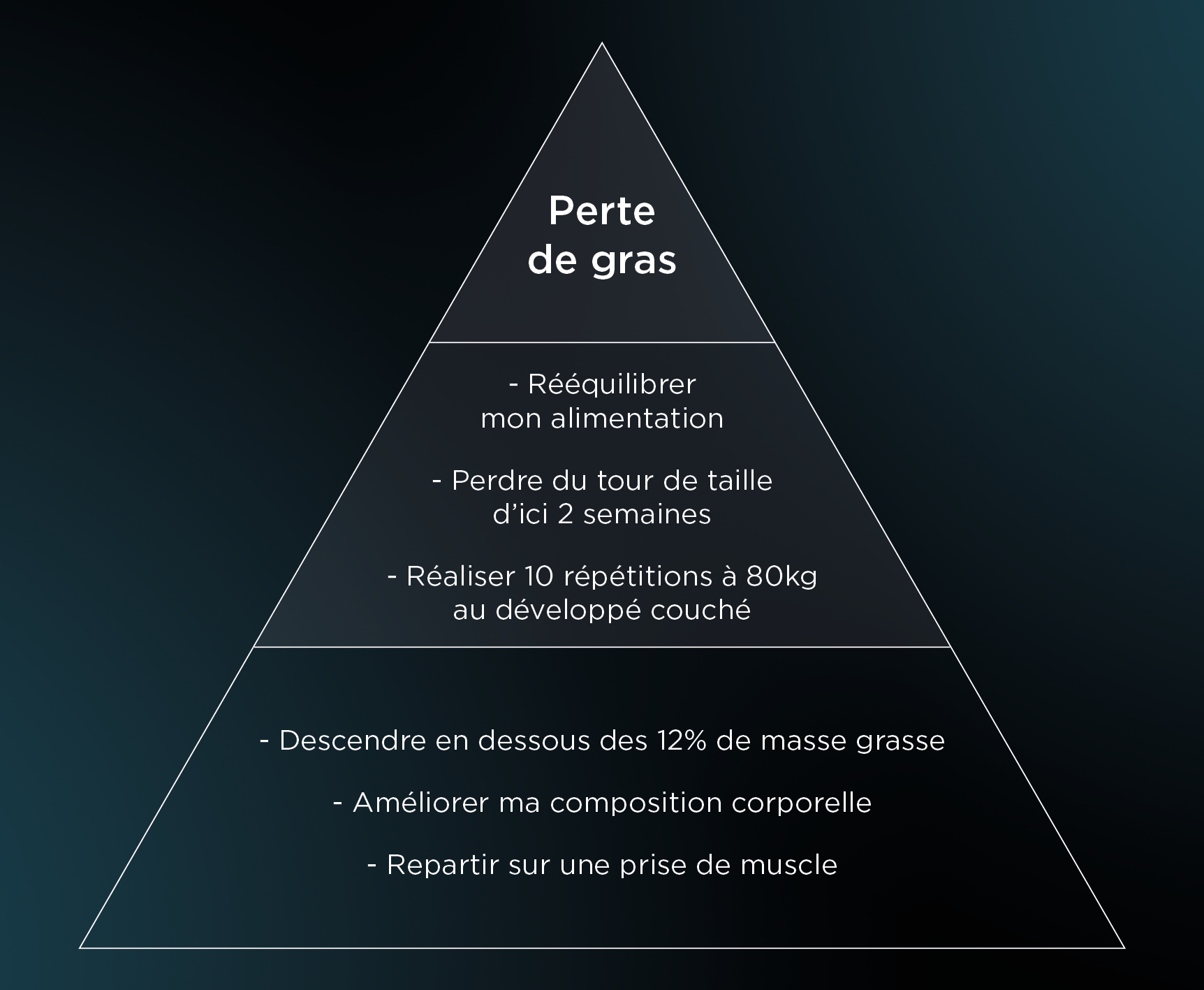
3) Comment adapter sa diète selon son objectif ?
La première chose à faire, sera de calculer tes besoins énergétiques.
Comme je l’ai expliqué dans un ancien article, la balance énergétique détermine à elle seule l’évolution de ton poids. C’est simple : si tu consommes plus de calories que tu n'en dépenses, tu prendras du poids. Et si tu dépenses plus de calories que tu n'en consommes, tu perdras du poids.
Pour connaître ta maintenance calorique (c’est-à-dire le nombre de calories qui ne te fera ni prendre, ni perdre de poids), tu vas devoir utiliser une formule qui est présentée ici :
COMMENT CALCULER SES BESOINS CALORIQUES
Par la suite, tu n’auras plus qu’à mettre en place un surplus calorique si tu es en prise de muscle, ou un déficit calorique si tu es en perte de gras.
Je te conseille de commencer doucement et d’y aller progressivement. Pour te donner un ordre d’idée, applique tout d’abord, un surplus/déficit de 5% de ta maintenance calorique. Par exemple, si ta maintenance est de 2500 kcal, tu devras retirer ou ajouter 125 kcal, suivant ton objectif : 2500 x 5% = 125 kcal
- Prise de muscle : 2625 kcal
- Perte de gras : 2375 kcal
Si, après quelques semaines, tu vois que ton poids et tes mensurations stagnent, alors augmente petit à petit ce déficit/surplus.
À côté de ça, tu devras évidemment privilégier des aliments bruts et complets et éviter les produits ultra-transformés.
Le plus important sera d’allier des produits de qualité à des plats savoureux. Je ne connais rien de plus horrible, que de devoir manger des plats dépourvus de saveurs...
“Je suis d’accord, mais je n’ai personnellement pas le temps de cuisiner. D’ailleurs, j'ai horreur de ça.”
Que tu n’aimes pas cuisiner, c’est une chose. Mais le temps n’est pas une excuse.
Il est tout à fait possible de prendre 20 à 30 minutes de ton temps, pour confectionner des plats vraiment savoureux.
D’ailleurs, pour te motiver à cuisiner plus souvent, je te partage 2 recettes, simples et rapides à réaliser. La première est à privilégier en prise de muscle, la seconde pour une perte de gras. Comme ça, pas de jaloux ! :)
PRISE DE MUSCLE
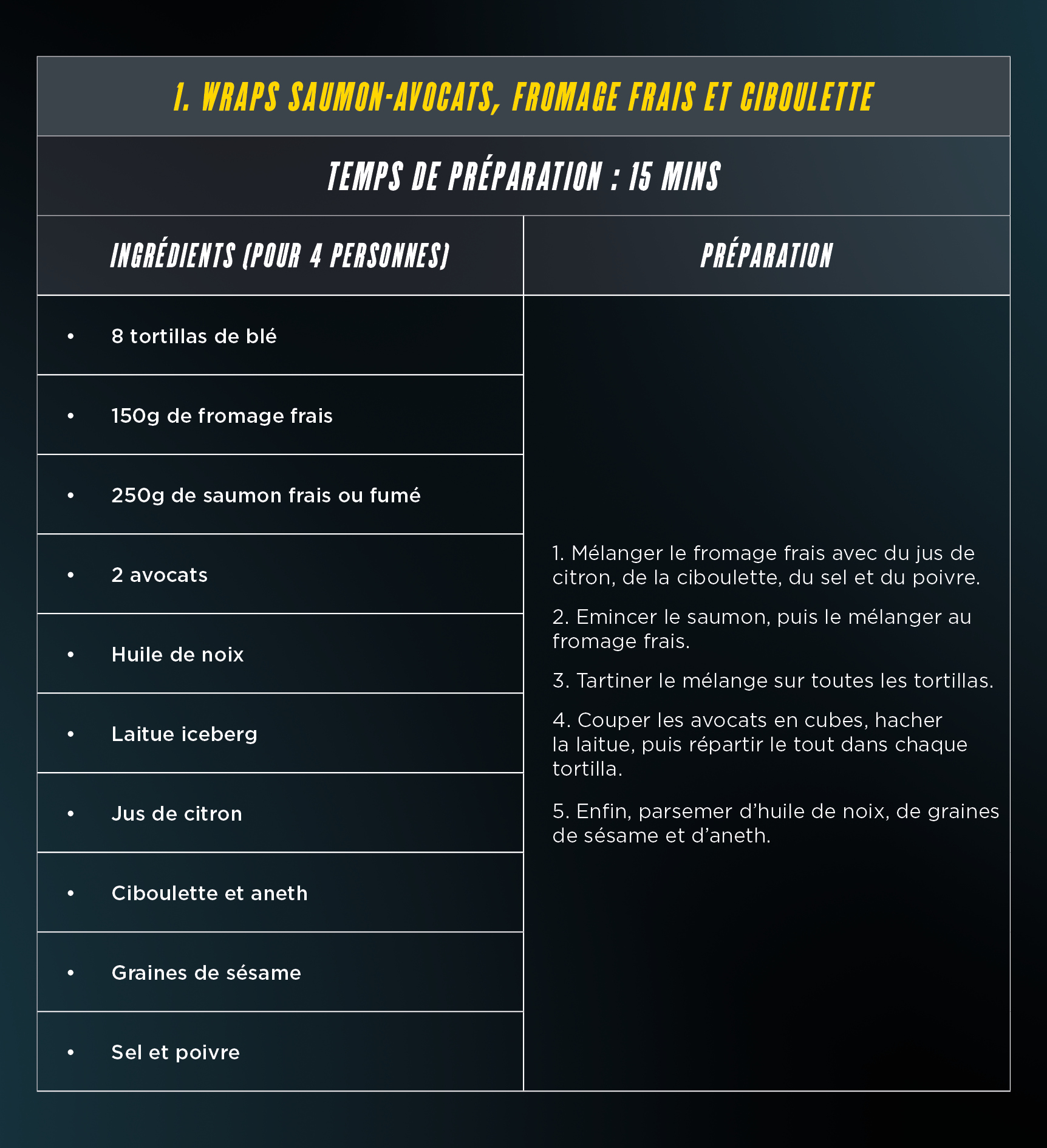
PERTE DE POIDS
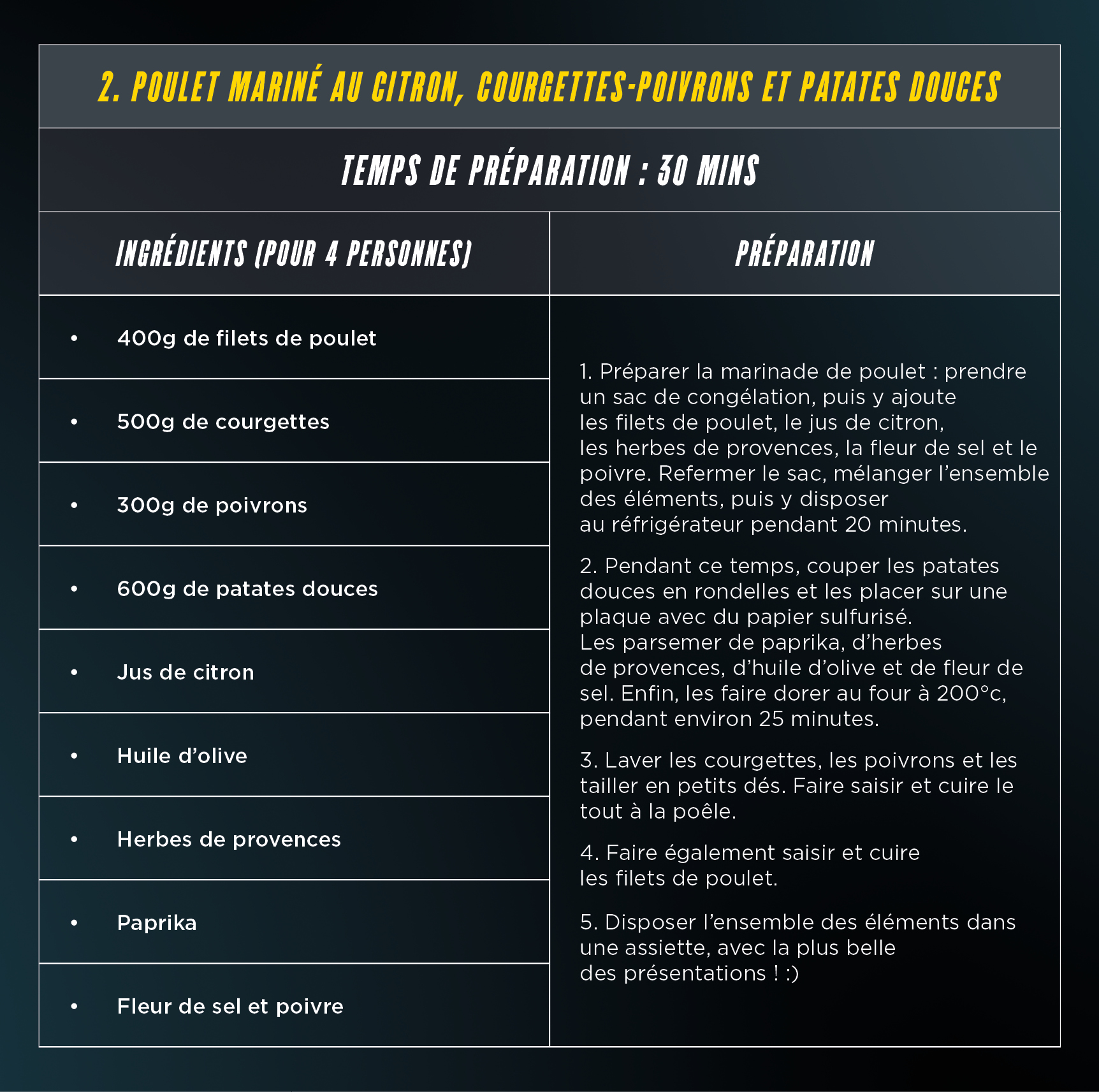
“30 minutes pour préparer un seul plat ? C’est beaucoup trop long…”
C’est pour ça que je te conseille de cuisiner en grande quantité. Comme tu peux le voir, mes recettes sont prévues pour 4 personnes. Si tu es seul, ça te fera 4 repas ! Ou plus, si tu n’as pas grand appétit.
4) Comment adapter son entraînement au retour de vacances ?
Et oui ! Tu dois à un moment ou un autre reprendre l’entraînement.
Mais pas de soucis à te faire car il suffit à priori de reprendre ton ancien programme non ? Et bien NON !
Si tu fais ça, il va se passer 2 choses :
1- Tu ne progresseras pas, car les charges seront beaucoup trop lourdes.
2- Ton corps ne pourra pas récupérer correctement et toi tu seras sans cesse fatigué.
Et point optionnel : L’accumulation de fatigue trop importante te mènera tout droit à la blessure. C’est parfait, toutes les conditions seront réunies pour mettre un terme à ta pratique sportive...Ça n’est pas ce que tu veux, pas vrai ?
Donc, première chose à faire : ne pas reprendre ton ancien programme. Ça, c’est dit !
Se créer une nouvelle routine d’entraînement sera pour toi la meilleure façon d’optimiser ta reprise.
Pour ce faire, tu devras obligatoirement diminuer ton volume d’entraînement et tes charges de travail. Pas facile de mettre son égo au placard, n’est-ce pas ?
Fais moi confiance, si tu suis à la lettre l’ensemble de mes consignes, tu pourras reprendre tes anciennes charges d’ici quelques semaines. Chaque chose en son temps ! ;)
Une bonne ligne directrice serait de baisser les charges de l’ordre de 15% à 20%, en se concentrant sur l’exécution du mouvement et le ressenti musculaire.
Imaginons qu’avant les vacances, tu arrivais à enchaîner 10 répétitions à 100 kg au développé couché. Tu devras alors prendre 80 à 85kg, pour réaliser ce même nombre.
Et enfin, pour ce qui est de ton nombre de séries, tu peux le diviser par 1,3.
Donc, si tu avais 15 séries par groupe musculaire, tu devras reprendre avec 10 à 11 séries.
À côté de ça, ton programme devras être composé majoritairement de mouvements polyarticulaires, et ce pour 3 raisons :
1- Ils apportent les meilleures adaptations nerveuses. C’est exactement ce qu’il te faut ! Après plusieurs semaines sans entraînement, ton système nerveux est pour ainsi dire, resté en vacances. Il aura donc besoin d'une remise à niveau et toi, d’un réapprentissage moteur.
2- Les mouvements poly-articulaires se basent sur le travail inter-musculaire pour soulever une charge. De ce fait, un maximum de muscles est recruté, ce qui est un avantage certain pour la prise de muscle.
3- Puisque plusieurs groupes musculaires travaillent en synergie, la dépense calorique sera plus importante ! Ce qui est un avantage certain pour la perte de poids.
Tu es gagnant sur tous les tableaux !
Si avec l’ensemble de ces indications, tu n’arrives toujours pas à créer ton programme, je ne peux plus rien pour toi… :D
Allez, puisque je suis sympa, voici 3 séances en full body, que tu pourras incorporer directement dans ton programme ! :
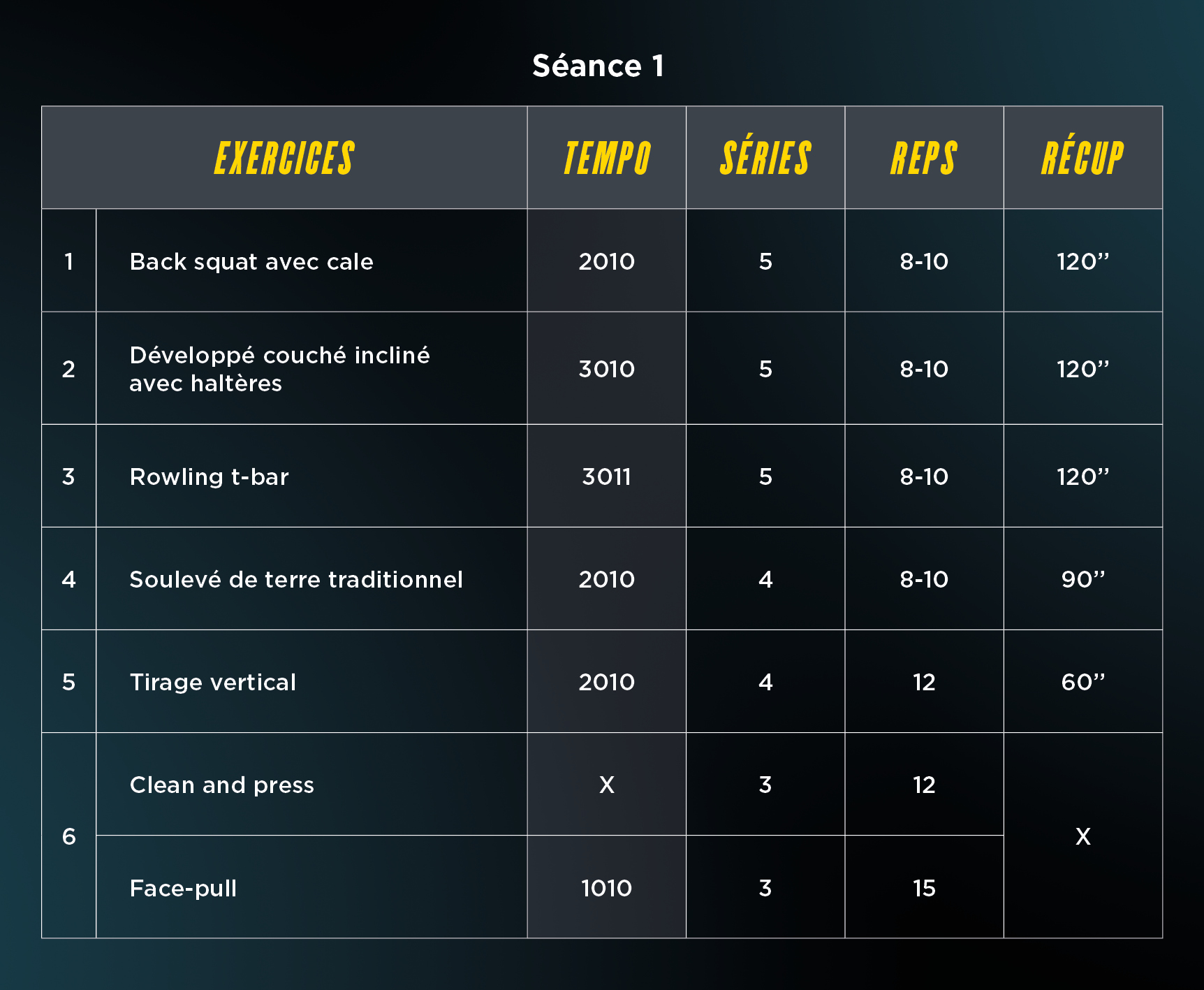
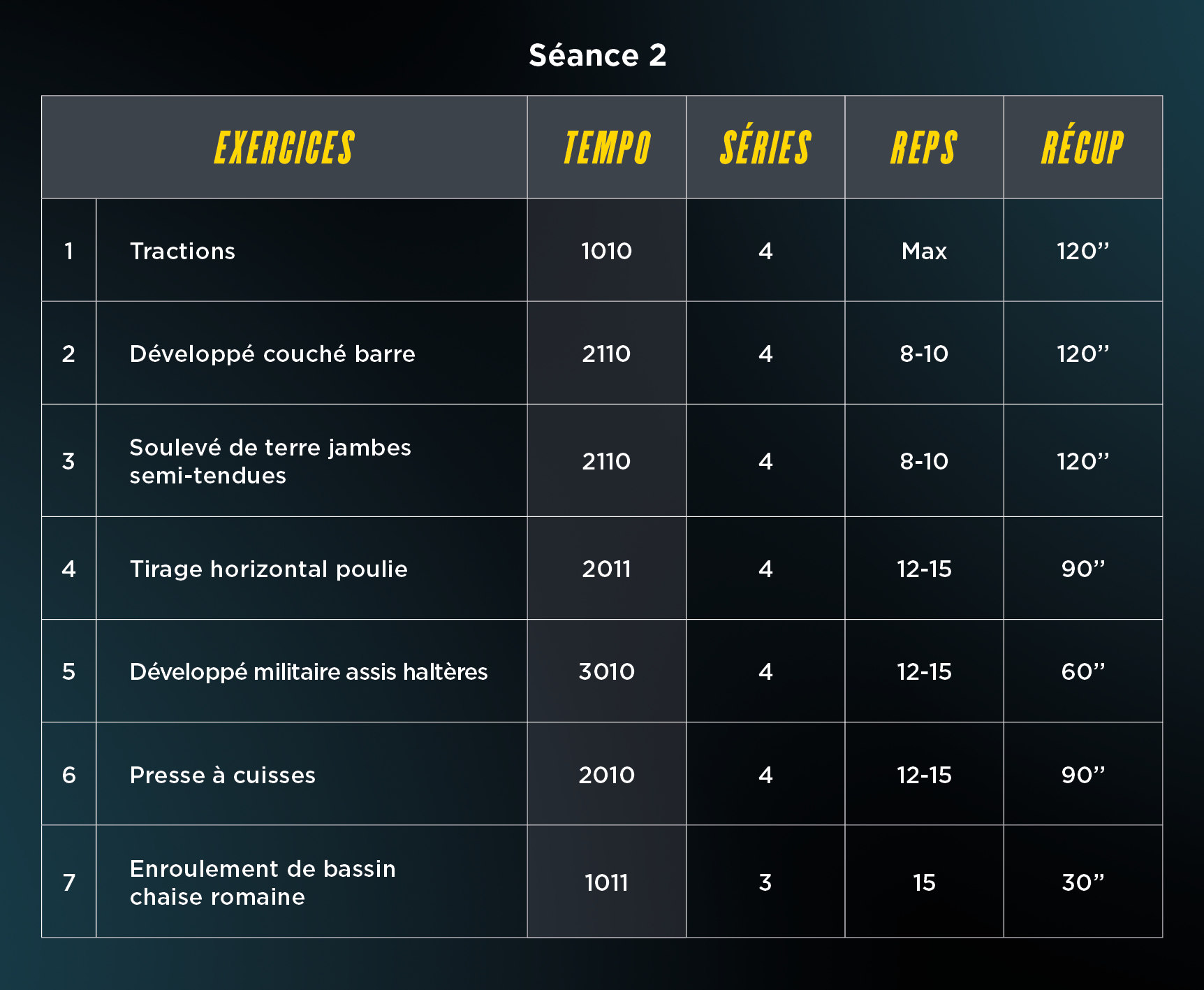
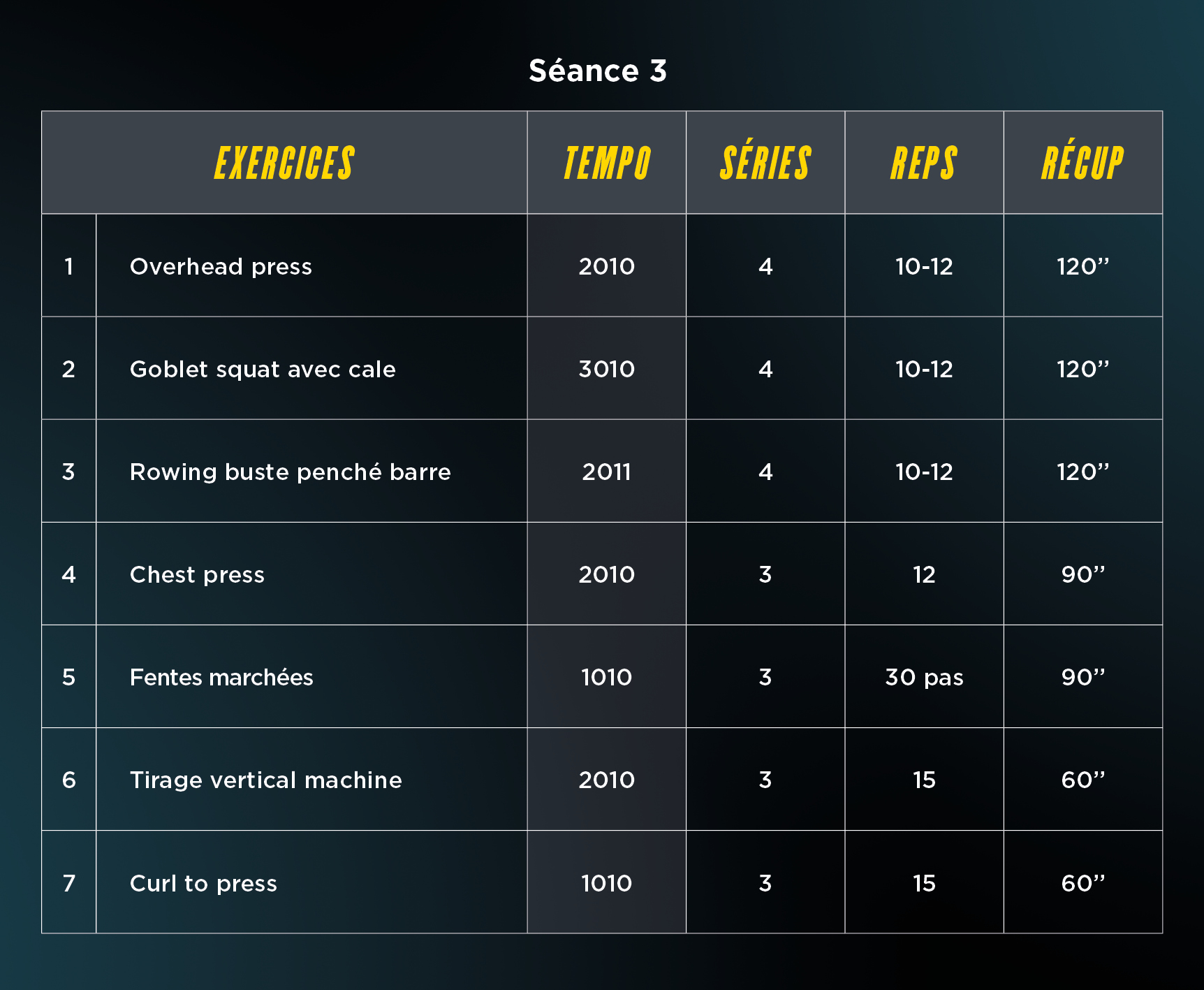
Conclusion
Tu sais maintenant comment gérer ton retour de vacances. Tu vois, il n’y a rien de sorcier.
Si tu prends suffisamment les devants pour optimiser l’ensemble de ta programmation, la progression ne sera pour toi qu’une évidence ! Allez, au travail ;)
Évidemment, le nombre de séries est à adapter selon ton niveau.
Consacre 5-10 minutes d’échauffement avant chaque séance.
Pour la reprise, je te conseille de programmer 3 à 4 entraînements par semaine et d’avoir au moins un jour de repos entre chaque entraînement.
 Offre spéciale : Les 4 premières semaines à 19€
Offre spéciale : Les 4 premières semaines à 19€
